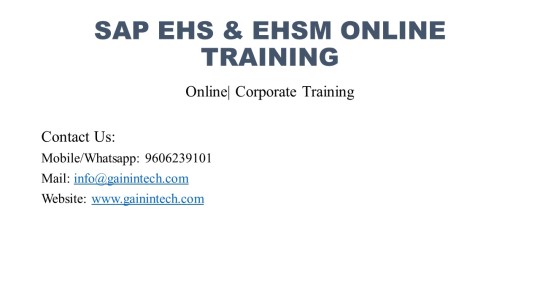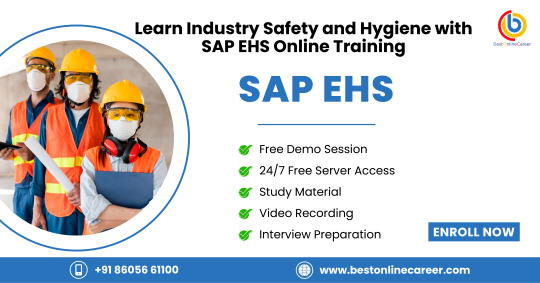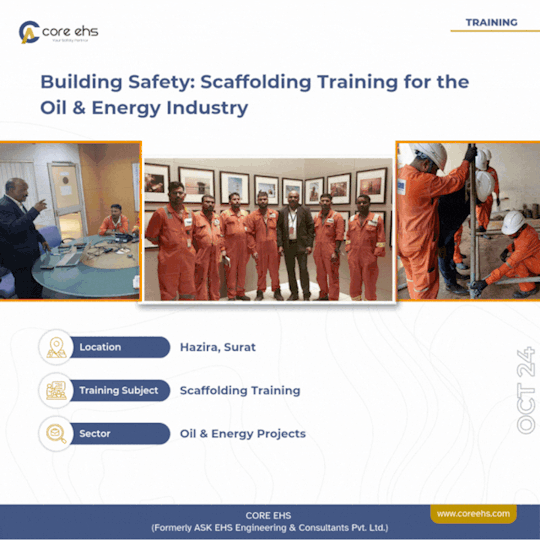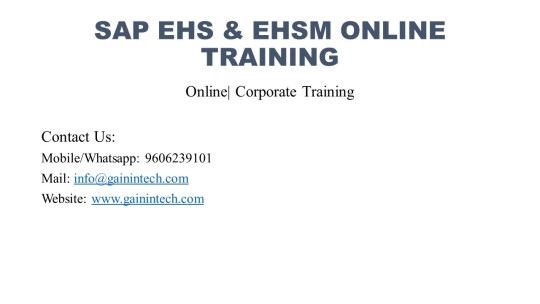#ehstraining
Explore tagged Tumblr posts
Text
🔱 Wishing You a Blessed Maha Shivratri! 🔱
May the divine blessings of Lord Shiva bring peace, prosperity, and protection into your life. 🙏✨
🛡️ From all of us at Northstar Safety Systemz, stay safe and blessed!
#MahaShivratri #HarHarMahadev #ShivratriBlessings #NorthstarSafetySystemz #StaySafe #DivineProtection
0 notes
Text
Become a Certified Scaffolding Inspector! Register for CORE EHS upcoming Training today. Connect with us for more details!
#ScaffoldingInspector#ScaffoldingTraining#CertifiedInspector#SafetyTraining#EHSTraining#ConstructionSafety#WorkplaceSafety#OSHATraining#COREEHS#ScaffoldingCertification#ConstructionProfessionals#SafetyFirst#WorkplaceCompliance#ScaffoldingSafety#TrainingOpportunity
0 notes
Photo

We are going to start new batch on SAP EHS & EHSM Online Training. If you are interested please do call on
Mobile: 9606239101
Mail: [email protected]
#technology#experience#training#safety#sap#bangalore#enironmental#health#ehs#ehsm#onlinetraining#onlinecourse#ehstraining#ehsmtraining#india#sap training#sap online training
1 note
·
View note
Text

Do you want to transition from SAP EHS employment to core SAFETY, COMPLIANCE jobs?
Then our SAP EHS Online Training will help you. Best Online Career offers online training in SAP EHS with professional knowledgeable consultants at a reasonable cost.
Additionally, you will have access to the lecture recordings on video, also you will get 100% Placement Assistance
Visit Website: https://bit.ly/39RJGj1
or Contact Us: +91-8605661100
#sap#sapcourses#saptraining#sapcertification#sapclasses#sapehs#sapehstraining#sapehsonlinetraining#ehstraining#ehscertification#ehs#ehscourses#sap consultant#best sap training online usa
0 notes
Video
instagram
I think #kona might be feeling a bit #relaxed, what do you think? #equinehannasomatics #hannasomatics #hannasomaticeducation #ehs #pony #morningstarfarm #sleepy #learning #education #ehstraining #ehstraining2018 #equinemassage #equinebodywork #equinebodyworker #bodywork #massage #relax #unwind #naptime #processing #thinking #somaticprocessing (at Morning Star Farm)
#bodywork#education#sleepy#equinehannasomatics#ehs#equinemassage#ehstraining2018#equinebodywork#kona#equinebodyworker#ehstraining#thinking#pony#somaticprocessing#learning#processing#naptime#hannasomaticeducation#morningstarfarm#relax#hannasomatics#massage#relaxed#unwind
2 notes
·
View notes
Text

“Ensuring safety and efficiency in the Oil & Gas sector—because safety is not an option, it’s a priority. Trust us to safeguard your operations, people, and the environment. 🌍⚙️
#OilAndGasSafety#WorkplaceSafety#SafetyFirst#OperationalExcellence#NorthStarSafety#IndustrialSafety#RiskManagement#SafetySolutions#ehs training#ehstraining
0 notes
Text

"Building Safety, Securing Success in Every Step." We’ve successfully completed a comprehensive Scaffolding Training program tailored for the oil & gas industry staff. This training equips participants with critical skills in scaffold erection, inspection, and safe working practices, ensuring compliance with industry standards and promoting safer job sites. Visit us -https://coreehs.com/ehs-trainings/
#BuildingSafety#scaffoldingtraining#oilandgas#safetyfirst#ComplianceMatters#saferjobsites#TrainingSuccess#WorkplaceSafety#skillsdevelopment#IndustryStandards#safety#ehs#EHSTraining#safetytraining#scaffold#industrial#safeworkplace hashtag#industrialwork#hazira
0 notes
Text

"Building Safety, Securing Success in Every Step." We’ve successfully completed a comprehensive Scaffolding Training program tailored for the oil & gas industry staff. This training equips participants with critical skills in scaffold erection, inspection, and safe working practices, ensuring compliance with industry standards and promoting safer job sites. Visit us -https://coreehs.com/ehs-trainings/
#BuildingSafety#SafetyFirst#ConstructionSafety#SafetyCulture#RiskManagement#WorkplaceSafety#SafetyStandards#oilandgas#oilandgasindustry#scaffolding#scaffoldtraining#EHS#EHSTraining#safety#worksite
0 notes
Text
SAP EHS Online Training | Attend Free SAP EHS Demo
Do you want to transition from SAP EHS employment to core SAFETY, COMPLIANCE jobs?
Then our SAP EHS Online Training will help you. Best Online Career offers online training in SAP EHS with professional knowledgeable consultants at a reasonable cost.
Additionally, you will have access to the lecture recordings on video, also you will get 100% Placement Assistance.
Visit Website: https://bit.ly/39RJGj1
or Contact Us: +91-8605661100
#sap#sapehs#saptraining#sapcourse#sapclasses#sapcertification#ehs#ehstraining#ehscourses#ehscertification
0 notes
Photo

Warm Greetings from Gain In Technology- Bangalore, IN.
We are supporting SAP Real-Time Online Training with Industrial Experts who have min 8 yrs of experience.
Find below to get more details about SAP EHS & EHSM Training
Module: SAP EHS & EHSM(Environmental, Health & Safety)
Duration: 35 to 40 hrs
Batch : Depends on Consultant availability
Meeting Software: GoToMeeting
Materials: Daily Class recording, Trainer hands-on Document.
Server Access: 3 Months
We are started a new batch on Monday on SAP EHS if anyone interested, please Contact us on
Timing: 09:00 PM IST (Monday- Friday)
Mobile/Whatsapp: 9606239101
Mail: [email protected]
Reference:
https://lnkd.in/e_DcAyU4
https://lnkd.in/gpv56KgZ
#technology #experience #training #safety #sap #bangalore #environmental #health #safety #ehs #ehsm #onlinetraining #onlinecourse #ehstraining #ehsmtraining #India #saptraining #saponlinetraining #safetyoffice #hseoffice #hsemanager #hsejobs #safetyandhealth
0 notes
Photo

Warm Greetings from Gain In Technology- Bangalore, IN. We are supporting SAP Real-Time Online Training with Industrial Experts who have min 8 yrs of experience. Find below to get more details about SAP EHS & EHSM Training Module: SAP EHS & EHSM(Environmental, Health & Safety) Duration: 35 to 40 hrs Batch : Depends on Consultant availability Meeting Software: GoToMeeting Materials: Daily Class recording, Trainer hands-on Document. Server Access: 3 Months We started a new batch on Monday on SAP EHS if anyone interested, please Contact us on Timing: 09:00 PM IST (Monday- Friday) Mobile/Whatsapp: 9606239101 Reference https://lnkd.in/e_DcAyU4 https://lnkd.in/gpv56KgZ #technology #experience #training #safety #sap #bangalore #environmental #health #safety #ehs #ehsm #onlinetraining #onlinecourse #ehstraining #ehsmtraining #India #saptraining #saponlinetraining #safetyoffice #hseoffice
0 notes
Photo

Warm Greetings from Gain In Technology- Bangalore, IN. We are supporting SAP Real-Time Online Training with Industrial Experts who have min 8 yrs of experience. Find below to get more details about SAP EHS & EHSM Training Module: SAP EHS & EHSM(Environmental, Health & Safety) Duration: 35 to 40 hrs Batch : Depends on Consultant availability Meeting Software: GoToMeeting Materials: Daily Class recording, Trainer hands-on Document. Server Access: 3 Months We are starting a new batch from Monday on SAP EHS if anyone interested please Contact us on Mobile/Whatsapp: 9606239101 Mail: [email protected] Reference: https://lnkd.in/e_DcAyU4 https://lnkd.in/gpv56KgZ #technology #experience #training #safety #sap #bangalore #environmental #health #safety #ehs #ehsm #onlinetraining #onlinecourse #ehstraining #ehsmtraining #India #saptraining #saponlinetraining
0 notes
Link
Welding task require strict safety measures to be followed as it carries risks to eyes and skin. The infographic explains various risks to be taken for safety during welding operations.
0 notes
Link
Safety Audit consists almost all aspects of safety like Fire Safety, Electrical Safety, Health & Hygiene, Chemical and construction safety. The audit is carried out as per IS 14489 :1998 on "Code of Practice on Occupational Safety & Health Audit" to check the compliance with the Factories Act, 1948 and Rules for respective states, The Environmental Protection Act & Rules, the CEA Regulations, the Explosives Act & Rules and other important Indian Statutory requirements and Standards.
0 notes
Link
Housekeeping is one of the most important component of safety. A clean and organised workplace is the first step towards safety. The infographic depicts key housekeeping factors to ensure safety.
0 notes
Text
HOW TO ENSURE CONTRACTOR SAFETY?
· The term 'Contractor' refers to any individual or organisation who enters into an agreement (either written or orally) with a company to carry out services
· Contract workers are a vulnerable population. Of the 4,836 fatal work injuries in 2015, 17% were to contracted workers, according to the Bureau of Labor Statistics
· With contractors often performing higher risk jobs in work sites with little to no management supervision, one of the best practices in an employer's safety and health program is to have a formal contractor management program
· Manage health and safety of Contractor workers (5 key points)
1. Planning: companies should-
a) Plan what the contractor’s job involves and how it can be done safely
b) Define the scope of the work
c) Risk assessment of significant potential hazards to health and safety
d) The company should develop a bid list through a formal or informal pre-qualification process which includes the above
2. Selecting a contractor:
a) In order to be satisfied as to the competency of the contractor in the management of health and safety, it is common for companies to send out or use a pre- qualification check list at the tendering stage
b) The Contractor should also enquire about What H&S competence is needed, should go through information about job and site and ask for a safety method statement
3. Working on Site: Once a contractor commences work on site it is important that they are aware of the site safety rules that apply to them and any particular hazards that they face. It is good practice to:
a) Control the coming and going of contractors in and out of the premises
b) Name a site contact (someone to get in touch with on a routine basis or if the jobs changes and there is uncertainty about what to do)
c) Establish a timetable for formal and regular review of the contractors safety management system through inspections, audits and safety meetings
d) Provide induction on the site conditions, facilities, safety rules and practices required
4. Keeping a check: Having established a timetable for inspections and audits of the contractor’s health and safety management system it is important that this is undertaken in order to ascertain how the job is going, in particular:
a) Is it going as planned?
b) Are the contractors health and safety systems actually in place and are they being followed? Are they working safely?
c) Have there been any incidents?
d) Are any other special arrangements necessary?
5. Reviewing the work: Once the job has been completed it is necessary to review the job. A review should be used to improve on future contracts and should include-
a) A review of the outcomes and achievements of the contractor
b) Verification of the adequacy of procedures in place
c) Amendment or addition to the procedures if necessary
d) Recording and rating the overall performance of the contractor against established criteria
e) Provision for feedback to contractor
0 notes